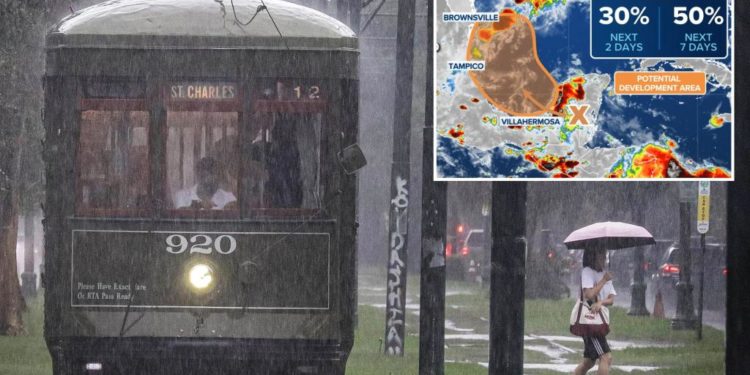As the Atlantic hurricane season approaches its peak, the Gulf of Mexico is once again at the center of weather forecasts due to the growing likelihood of tropical cyclone formation. Every year from June 1st to November 30th, the Atlantic basin enters a heightened period of activity, with tropical storms and hurricanes posing significant risks to coastal communities. The period from mid-August to late October is often the most dangerous, as warm ocean waters and atmospheric conditions combine to create the perfect environment for storms to develop. In 2024, this trend continues, with meteorologists closely monitoring potential disturbances brewing in the Gulf.
For residents along the Gulf Coast, including areas in Texas, Louisiana, and Mexico, the potential for a tropical cyclone developing in the coming days has raised concerns. While tropical disturbances are a regular part of life for these communities, the timing and strength of these storms can vary widely. During the peak of the hurricane season, even small disturbances have the potential to grow rapidly into significant hurricanes, given the right conditions. This is especially true in the Gulf of Mexico, where warm waters provide the energy needed for storm systems to intensify.
The risks are not confined to the Gulf of Mexico, either. The broader Atlantic basin is also being closely watched for additional storm development. According to the National Hurricane Center (NHC), multiple disturbances have been observed, each with varying degrees of potential to strengthen into tropical storms or hurricanes. As of this writing, the most immediate concern remains the Gulf of Mexico, where a low-pressure system could organize into a tropical depression or storm within the next few days.
While it is too early to predict the exact trajectory and intensity of the system, forecasters are urging residents in Texas, Louisiana, and parts of Mexico to stay informed. In the past, storms in the Gulf have been known to change course or intensify quickly, sometimes catching residents off guard. As the Atlantic hurricane season enters its peak, the need for preparedness cannot be overstated.

The tropical disturbance in the Gulf of Mexico is expected to strengthen as the Atlantic hurricane season peaks on September 10, 2024. This system, which has traveled across the Atlantic, is now near Belize and Mexico’s Yucatan Peninsula. It could potentially become a tropical depression by early to mid-next week, with a 60% chance of development over the next seven days. This growing activity aligns with the peak of the season, when conditions are most favorable for storm formation(Interaksyon).
However, the system’s behavior is still uncertain. If it moves toward Mexico earlier, it may remain a disorganized tropical depression, producing mainly rain. The longer it stays over water, though, the greater the chance of intensification. Meteorologists are also keeping an eye on a second wave in the central Atlantic, which has a lower (20%) chance of becoming an organized system within the next seven days.
The Gulf of Mexico is particularly prone to rapid storm intensification due to its warm sea surface temperatures. In previous years, storms that have formed in the Gulf have gone on to become some of the most devastating hurricanes in U.S. history, such as Hurricane Harvey in 2017 and Hurricane Laura in 2020. Both storms underwent rapid intensification, catching many residents by surprise and leading to significant damage along the Gulf Coast.
Aside from the immediate threat in the Gulf, the broader Atlantic basin is also showing signs of increased activity. The Atlantic hurricane season typically peaks around September 10th, with a noticeable uptick in the number of tropical disturbances forming during this period. As of now, forecasters are watching two other systems in the Atlantic. One is located near the western coast of Africa and has a low chance of development, while another is currently in the central Atlantic and poses no immediate threat to land.
As the Atlantic hurricane season enters its most active phase, the potential for tropical cyclone formation in the Gulf of Mexico serves as a stark reminder of the risks posed by these powerful storms. With warm ocean waters and favorable atmospheric conditions in place, even seemingly minor disturbances have the potential to rapidly intensify into dangerous tropical storms or hurricanes. For residents along the Gulf Coast, the next few days will be crucial in determining the level of risk posed by the developing system in the Gulf.
While it remains unclear whether the system will make landfall as a tropical storm, hurricane, or remain a weaker tropical depression, the need for vigilance is clear. Residents in Texas, Louisiana, and parts of Mexico should closely monitor updates from the National Hurricane Center and local authorities. It is always better to be over-prepared than underprepared when it comes to tropical storms, as even weaker systems can cause significant flooding and wind damage.
The broader Atlantic basin also warrants attention, as multiple disturbances could develop into tropical systems in the coming weeks. The peak of the hurricane season is a time of heightened risk, and the Gulf of Mexico is often at the center of this activity. Historically, storms that form during this period can quickly become dangerous, with the potential for loss of life and property.
Preparedness is key during hurricane season. This includes having an evacuation plan in place, stocking up on emergency supplies, and staying informed through trusted weather sources. Whether or not the system in the Gulf reaches hurricane status, the possibility of tropical storms affecting the region serves as a timely reminder that nature’s power should never be underestimated.
As we move deeper into the 2024 hurricane season, it is essential to remain alert. Meteorologists and forecasters will continue to provide updates, but residents must take responsibility for their own safety by heeding warnings and preparing accordingly. The Gulf of Mexico may see additional activity before the season ends, so the importance of readiness cannot be overstated. By staying informed and taking proactive measures, communities along the Gulf Coast can mitigate the risks associated with tropical cyclones and protect themselves from the worst impacts of these powerful storms.
